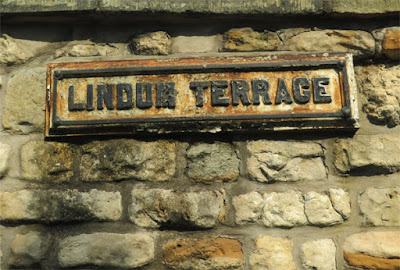 |
| A detail of a boundary wall on Lindum Terrace |
At the start of my day out in Lincoln, from the church of St. Mary-le-Wigford until I reached the Stonebow, I had been walking around a relatively flat part of the city, which is underlain by Quaternary river terrace deposits and alluvium that covers the valley of the River Witham.
 |
| A geological map of Lincoln city centre |
Although overlain by man-made deposits of great interest to the archaeologist and current buildings, the underlying bedrock - the Charmouth Mudstone Formation – emerges from beneath these superficial Quaternary deposits and forms the rising ground upon which Broadgate is laid.
 |
| The Whitby Mudstone Formation |
Just beyond the junction with Monks Road, the angle of slope steeply rises to form the escarpment, with the appearance of the overlying Whitby Mudstone Formation, the Northampton Sand Formation and finally the Lincolnshire Limestone Formation, which forms a hard resistant cap to the softer sediments beneath it.
Walking up Lindum Road, which runs diagonally up the escarpment, Lincoln Cathedral towered above me to the north and, in places where there were no buildings or trees, I was able to get clear views of the escarpment to the south at Canwick Hill.
With the Usher Gallery and The Collection being closed due to the COVID-19 Pandemic, although various interesting features can be seen in the surrounding gardens, including a section of Roman wall, I continued up the hill – stopping only to photograph the Lincolnshire College of Art and Design, which has fine examples of decorative brickwork and terracotta.
Carrying on up past various listed buildings on the north side of Lindum Road, a stretch of boundary walling on the corner with Lindum Terrace caught my eye, where some of the colours in the stonework were obviously different to the Lincoln stone used in the wall on the south side.
The bulk of the stone is yellowish Lincoln stone, complete with its typical very irregular pattern of fracture, with some similar limestone that contains pale blue/grey colour variation. I had seen both before during my time spent living in Lincoln, however, the wall also contains many blocks of blue/grey limestone with a sharp transition to a rusty orange colour, which I had never seen before.
Having since undertaken some desktop research, these would appear to be examples of the basal part of the Lincolnshire Limestone known as the 'Blue beds', composed of very sandy ferruginous limestone that is overlain by a well bedded oolitic limestone known as the 'Nerinea beds' – based on the abundance of this genus of gastropod.
This horizon, known as the 'Silver beds' in Lincoln, is at a lower level than the Lincolnshire Limestone found at Ancaster and further south at Clipsham, Ketton and Weldon, which are uniform, thickly bedded and excellent building stones.
Looking closely, some of the blocks are covered in black, clinker like deposits that are often seen in areas subjected to very high levels of sooty atmospheric pollution. These encrustations can be rich in sulphurous compounds that react with the limestone to produce calcium sulphate, which crystallises in the pores and results in the blistering of the stone and loss of detail.








No comments:
Post a Comment